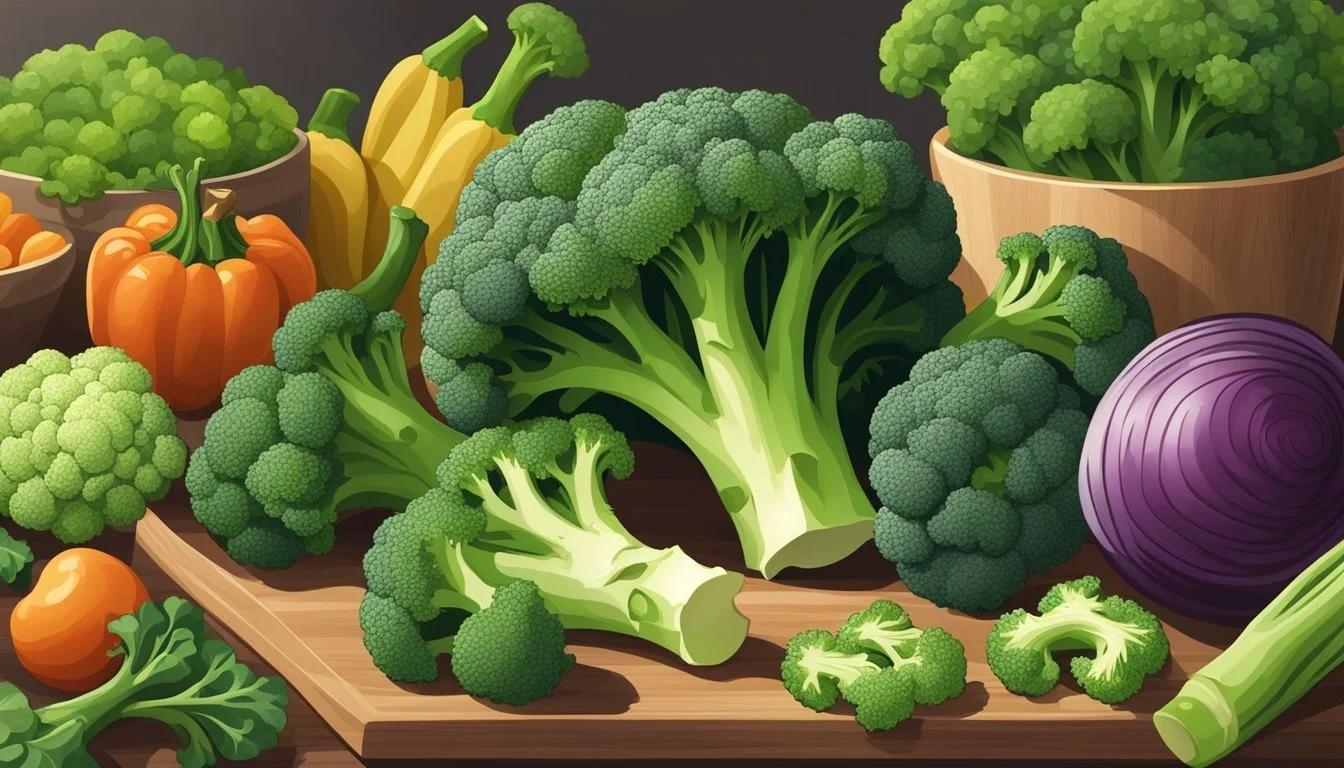Does Broccoli Go Bad?
Signs, Storage Tips, and Shelf Life
Broccoli, a staple in many kitchens, is known for its numerous health benefits, including high levels of fiber, vitamins, and minerals. This versatile vegetable is rich in calcium, vitamin C, and vitamin K, making it an excellent addition to a balanced diet. Like all fresh produce, though, broccoli does have a limited shelf life.
Recognizing when broccoli has gone bad is essential to avoid consuming spoiled food. Indicators of spoilage include yellow or brown spots on the florets, a sour or rotten smell, and limp or mushy textures. Any signs of mold, such as white or black fuzzy spots, mean it should be discarded immediately.
Proper storage techniques can prolong the freshness of broccoli. It can be stored whole or cut into florets, either in the fridge or freezer. Typically, it lasts between three to five days in the fridge. By keeping an eye on its color, smell, and texture, you can ensure that your broccoli remains a healthy and safe choice for your meals.
Understanding Broccoli Freshness
When assessing broccoli for freshness, look for specific visual and sensory cues. The appearance and scent provide clear indicators of the vegetable's quality and edibility.
Identifying Fresh Broccoli
Fresh broccoli should be bright green with firm florets. The stalk should also be firm and distinct in texture. Fresh broccoli's coloration is usually consistent, without yellowing or brown spots.
The smell should be mild and fresh. Cut broccoli may have a slightly stronger but not unpleasant smell. When buying, ensure the stalk is not wilted or mushy.
Signs of Broccoli Spoilage
Spoiling broccoli exhibits identifiable changes. Look for yellowed or brown patches on the florets and stalk. Mold growth, appearing as black spots or fuzzy patches, is a primary indicator of spoilage.
Texture changes are significant; soft or slimy florets signify bad broccoli. The odor can also indicate spoilage - an unpleasant odor suggests food poisoning risk, and the vegetable should be discarded immediately.
Proper Storage Techniques
Proper storage techniques can help maintain broccoli’s freshness and nutritional value. By following specific methods, one can significantly extend its shelf life and reduce food waste.
Storing Fresh Broccoli
To keep fresh broccoli crisp and nutritious, proper refrigerated storage is essential. Begin by wrapping unwashed broccoli in a damp paper towel to retain moisture. Store it in the crisper drawer of the refrigerator, ideally at a temperature of 32–36°F.
An airtight container or a loosely closed plastic bag can help minimize exposure to ethylene gas produced by other fruits and vegetables. This setup prevents the rapid aging of broccoli. Cut or cooked broccoli should be stored in airtight containers to preserve moisture and extend freshness.
Extending Shelf Life by Freezing
Freezing can further extend the shelf life of broccoli. To prepare, cut the broccoli into florets and blanch them in boiling water for about 2 minutes. Immediately transfer the florets to an ice bath to halt the cooking process. Drain and pat dry to remove excess moisture.
Arrange the florets on a parchment-lined sheet pan, spread them out in a single layer, and place them in the freezer. After 1-2 hours, transfer the frozen florets to freezer bags or an airtight container. Label the container with the date for tracking. This method maintains broccoli’s freshness for up to a year. Properly defrost before cooking to ensure optimal texture and flavor.
Preparation and Usage
Preparing broccoli properly is essential for maximizing its freshness, flavor, and nutritional value. There are several methods to clean and cook broccoli and many ways to incorporate it into various meals.
Cleaning and Cooking Broccoli
Cleaning
Before cooking, washing broccoli thoroughly is vital to remove any dirt or pesticide residue. Hold it under cold running water and use your fingers to gently rub the florets.
Blanching
Blanching is a quick method involving boiling water. Submerge the broccoli in boiling water for 2-3 minutes, then immediately transfer it to ice water to halt the cooking process. This preserves the vibrant green color and crisp texture.
Cooking Methods
Broccoli can be steamed, boiled, roasted, or sautéed. For steaming, place it in a steamer basket over boiling water for about 5-7 minutes until tender. Roasting involves tossing the broccoli in olive oil, seasoning it, and baking at 425°F for 20-25 minutes.
Incorporating Broccoli into Meals
Broccoli's versatility makes it a healthy addition to numerous dishes. Salads benefit from steamed or blanched broccoli, adding a crisp texture and fresh flavor.
Stir-Fries and Pasta
Stir-fry broccoli with other vegetables, proteins, and sauces for a quick, nutritious meal. It can also be mixed into pasta dishes for added nutrients and color.
Soups and Stews
Adding cooked broccoli to soups and stews can enhance their nutritional value and texture. Puree it for a smooth, creamy soup that's both appetizing and healthy.
Side Dishes
Simple side dishes can be made by sautéing broccoli with garlic and lemon, providing a tasty accompaniment to main courses. This method highlights the produce's natural flavors while keeping it healthy and appealing.
Recognizing and Responding to Spoilage
Properly identifying signs of spoilage in broccoli helps maintain food safety and quality. Key indicators include changes in color, texture, and smell, all of which signal that the broccoli may no longer be suitable for consumption.
Assessing Broccoli Condition
When assessing the condition of broccoli, color is a primary indicator. Fresh broccoli features vibrant green florets and stems. Yellow, brown, or black spots, or white fuzzy mold indicate spoilage. The broccoli should also be firm and crisp upon touch.
Feel the texture: fresh broccoli has a compact, tightly packed head and a firm stalk. Mushy, soft, or wilted textures suggest that the broccoli is past its prime. Also, the stem should not be dried out or cracked.
Smelling broccoli can provide additional clues. Fresh broccoli has a mild, earthy scent. If the broccoli emits a strong, pungent, rotten odor, or smells sour, it should be discarded.
Actions for Suspected Spoilage
If spoilage is suspected, consider sniffing and feeling the broccoli to confirm its condition. For broccoli exhibiting minor imperfections, such as slightly dry stalks with no other signs of spoilage, trimming the dried parts may make it usable.
If broccoli is found to be mushy, slimy, soft, or has significant changes in color or odor, it should be discarded immediately. Rinse any broccoli found to be on the border of spoiling in cold water to attempt** reviving** it. Placing it in ice water briefly can help restore some crispness.
Avoid consumption once there are clear indicators of spoilage to prevent health risks. Always check the expiration date when available, though visual and sensory inspections are paramount for recognizing spoilage effectively.
Shopping and Selection Tips
When shopping for broccoli at the grocery store, look for bright green or dark green florets. These colors usually indicate that the produce is fresh and full of nutrients.
The stalks should be firm and crisp. A bendy or limp stalk is a sign that the broccoli may not be as fresh.
Avoid broccoli with yellow or brown spots. These discolorations can indicate that the broccoli is starting to spoil. Similarly, black or white fuzzy spots are signs of mold and should be avoided.
It's important to check the texture of the broccoli. The florets should feel firm to the touch. If they easily fall apart or feel mushy, the broccoli is past its prime.
Smell is another indicator of freshness. Fresh broccoli will have a clean, earthy scent. A sour or rotten smell indicates that the broccoli has gone bad.
Buying pre-cut broccoli florets can be convenient, but whole broccoli heads tend to last longer. If you plan to store the broccoli for a few days, whole heads are a better option.
When storing broccoli, keeping it at room temperature can cause it to spoil quickly. It’s best to store it in the refrigerator to maintain its freshness.
These tips will help choose and store broccoli that is both fresh and nutritious, ensuring that it remains a healthy addition to meals.





